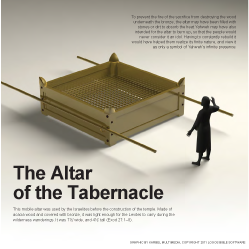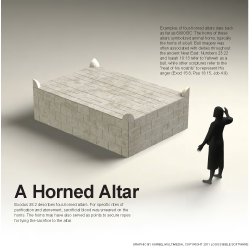27:1–8 This passage lists the instructions for the construction of the bronze altar, |
 Altars in the Old Testament Table
Altars in the Old Testament Table
27:1 cubits The Hebrew text gives measurements in cubits, a standard unit of the ancient world based on the length of the forearm (from the tip of the fingers to the elbow). One cubit equals about 1.5 feet.
its height The altar of the temple discovered at Arad is close to the dimensions described for the tabernacle’s altar.
is close to the dimensions described for the tabernacle’s altar.
27:2 horns Protrusions, mimicking the horns of a bull, at the four corners of the altar. The altar and the horns were carved out of one piece of wood. These appear in the archaeological record on altars, both small and large, that have been excavated at Megiddo, Tel Dan, Arad, and numerous other locations throughout the Levant. Sacrificial blood was placed on the horns in certain rituals of purification and atonement (e.g., Lev 4:25). In other rituals, horned altars were used for incense or to hold small bowls filled with small-scale offerings. Grabbing the horns of the bronze altar was a means of claiming political sanctuary, although this did not always end as hoped (1 Kgs 1:50–51; 2:28).
27:3 shovels and its sprinkling bowls and its forks Sacred utensils used to clear the altar of sacrificial remains, ashes, and embers.
27:4 a work of bronze network This grate allowed ash and fat drippings to fall into the flame under the altar. Such drainage was important because Israel was forbidden to eat any blood that remained in an animal (Gen 9:4) and most sacrifices were consumed, in part, by humans. In previous times, when the Israelites used stone altars (Exod 20:25), this drainage was ensured by making altars out of uncut stone rather than hewn stone.
27:7 when carrying it As with the ark of the covenant (25:10–22; 37:1–9) and the table (25:10, 23; 37:10–16), the altar of incense was designed to be carried without direct human contact.
27:8 it was shown you Here, Yahweh is speaking to Moses alone. Yahweh showed Moses the pattern of each element of the tabernacle. See note on 25:9.
27:9–19 This section describes the courtyard area surrounding the tent sanctuary. The courtyard put distance between the tabernacle’s entrance and provided space for the priests and worshipers to prepare the offerings. The sacrificial altar (30:28; 31:9; 38:1; 40:6–10) and the bronze basin (30:18) were located in this courtyard. |
 Tabernacle Materials and Equipment Table
Tabernacle Materials and Equipment Table
27:9 finely twisted linen The Hebrew term used here, shesh, derives from an Egyptian term denoting cloth of very high quality.
27:10 twenty pillars The material used for these support posts is not stated explicitly. The same Hebrew words for posts (ammud in Hebrew) and bases (eden in Hebrew) are used to describe the posts and bases used for the screens separating the sections of the tent sanctuary in ch. 26. Those posts are acacia wood overlaid with gold (see 26:32, 37). The support posts for the tabernacle enclosure were likely also acacia wood but with silver bands rather than a full metal overlay. The posts were not pure bronze. The record of what the various precious metals were used for in 38:24–31 only shows the metals used for the bases and capitals of the posts.
bands The small vertical bands between the flutes of the columns.
27:13 east For some cultures in the ancient Near East, the orientation of a deity’s dwelling was very important. The tabernacle and temple were both oriented eastward.
27:16 a screen of A curtain that hung across the main entrance to the tabernacle.
blue and purple and crimson yarns These were costly dyed yarns. See note on 25:4.
27:19 the equipment of For example, the pots and shovels for the bronze altar (vv. 3–4).
pegs That is, the tent pegs that secure the cloth panels that mark the boundary of the courtyard.
27:20–21 This short section deals with the oil for the lampstand. The lamp was to be kept burning in the tent all night long. Compare note on 25:31. |
27:20 pure, beaten olive oil The olive oil was to be clear, free of any particulates. To make oil, olives were pounded or crushed, either by hand in a pestle or by using an olive press. The oily pulp was then filtered through a strainer.
27:21 the tent of assembly In this context, the Hebrew phrase used here, ohel mo'ed, refers to the tent shrine within the tabernacle court. In other contexts, the label applies to the entire tabernacle complex (compare Lev 1:1–3).
before the testimony The lampstand was located in the Holy Place outside the veil that separated it from the Most Holy Place, the inner room where the ark of the covenant was kept (see Exod 25:16, 21–22; 26:33–34).

|
About Faithlife Study BibleFaithlife Study Bible (FSB) is your guide to the ancient world of the Old and New Testaments, with study notes and articles that draw from a wide range of academic research. FSB helps you learn how to think about interpretation methods and issues so that you can gain a deeper understanding of the text. |
| Copyright |
Copyright 2012 Logos Bible Software. |
| Support Info | fsb |
 Loading…
Loading…




